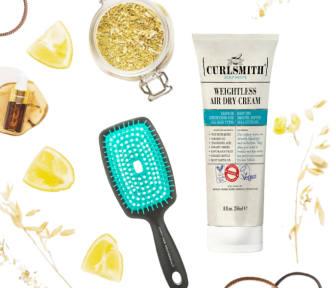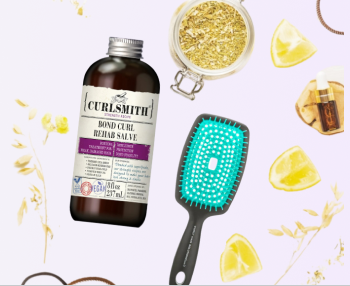Thanks to Sophie for writing this guest post for our curly readers about taking care of your hair when you’re chronically ill or have a disability. If you have any additional tips based on your own experience, please let us know and we'll add them to the bottom of this post.
By: Sophie H.
When I became sick with ME/CFS, a complex chronic illness usually triggered by viral infection, everything in my life got harder – school, chores, finances, and even curly hair care.
Soon, I was finding that my wash days were triggering PEM, or post-exertional malaise, which is a flare up of symptoms due to overexertion. And I was keeping my routine pretty simple, mind you. Basically, just cleansing, conditioning, and getting a brush through my thick curly hair was enough to make me sicker! I knew something needed to change.
Fortunately, with time and practice, I’ve been able to adapt and find strategies that work for my hair and my fluctuating health. I am grateful for the opportunity to share some of them here.
We don’t talk about chronic illness, disability, and accessibility enough in the curly community. Though experiences of disability are as diverse as our curl patterns (basically: the possibilities are endless!), here are some tips that may help make curly hair care more manageable alongside chronic illness and disability.

The Importance of a Good Curly Cut
In retrospect, I’m embarrassed by how slow I was to realize that a major haircut was a relatively simple way to make my hair much lower maintenance. I think it’s because a chunk of my identity was tied up in having big, long curly hair for basically my whole life. But once I made the decision to try out a curly pixie, I felt so much lighter – literally and figuratively.
Having shorter hair made my wash day so much easier. No more flare ups just from doing my hair! I still had big curly hair, just much shorter, and honestly much cleaner and healthier because I was able to actually take care of it.
If you’re thinking of taking the leap to a lower-maintenance haircut, check out these tips for a great curly cut.
Unscented and Fragrance-Free Product Options for Curly Hair
Lots of chronically ill folks have scent sensitivities. If this is something you struggle with – or if that’s the case for someone you live or work with – consider switching to fragrance-free hair products. Fortunately, there is a large and growing roster of curly products without added fragrances. Note that they might still smell faintly of some of the ingredients in the product, but though they may not literally be scent-free, they’ll certainly be much gentler! Consider starting with a travel size to see if a new product works for you.
Using Fewer Spoons for Drying Your Hair
Within chronic illness culture, spoons represent units of energy. This is called “spoon theory”, originally coined by Christine Miserandino. Those of us living with energy limiting conditions have to budget our spoons very carefully.
When my illness was more severe, I discovered plopping, which is a great way to cut down on drying time! You can plop using a microfibre towel or turban, or even a big ol’ cotton t-shirt. Lay your towel or tee out flat, and then place your wet hair in the middle, slowly lowering your head down until it’s touching the fabric. Secure and voila! (There are many great tutorials on YouTube if you’re new to plopping.) I find it a great way to dry my hair and set my curls, while taking a much-needed post-shower power nap.
If you’d prefer to diffuse your hair, but struggle with energy or dexterity limitations, there are a few potential options. Maybe you have a roommate or family member who might be willing to lend you a hand? Or, if you’re flying solo or prefer the independence, try out a hair dryer stand or a diffuser drying cap. That way you don’t have to hold up the hair dryer, and can have a nice sit while diffusing.
Protecting Your Curls at Night to Make Refreshing Easier
Lots of us with chronic illness need to spend extra time in bed, which means even greater opportunity for friction to cause frizz and breakage. The easiest way to be able to keep your hair intact for longer between wash days is to invest in sleep protection. Oh boy do I wish I’d known about this sooner!
If you haven’t yet, consider investing in a silk or satin pillowcase, bonnet, or scarf. If you’ve got longer hair, you could also try putting your curls up in a buff or a pineapple in a satin scrunchie.
Cleansing Your Scalp Properly is the Key to Extending Your Wash Day
If, like me, you like to really stretch it between wash days, it’s extra important to get a good cleanse of your scalp. If you have hand pain or dexterity struggles, it might be worth trying a shampoo brush. Mine has been a game changer for giving my scalp a nice massage while shampooing!
 Additions to Sophie's shower to assist with washing (photo by Sophie H.)
Additions to Sophie's shower to assist with washing (photo by Sophie H.)
Using Dry Shampoo as an Alternative to Washing Your Hair Today
Curlies all know those days when you need to get your day five, or six, or more (hey I’m the absolute last to judge!) hair to last another day or two. For those of us with energy-limiting conditions, the struggle is especially real. That’s where dry shampoo can come in handy! This blog post outlines some great options.
* * *
That’s it for my list! But I bet there’s lots more wisdom from disabled and chronically ill curlies out there. If you have other accessibility ideas that you want to share, send us an e-mail, and we’ll add them below.
Charlene adds: "One thing I would add is to protect the hair from the different elements. My curls are too fragile for braids or other protective styles due to medication and my illness, so I often resort to loosely styling with satin scrunchies if it's windy outside and wearing a satin lined hat on the winter. "








